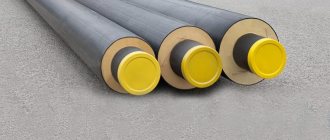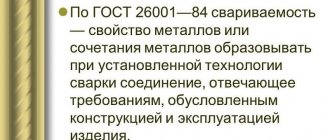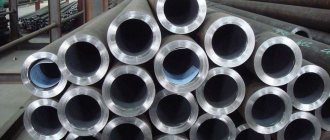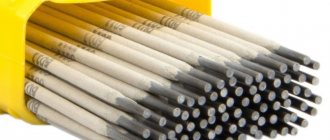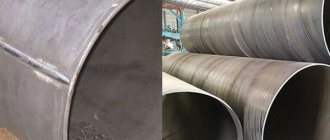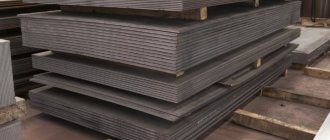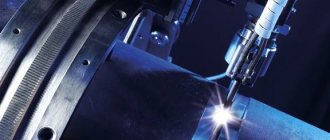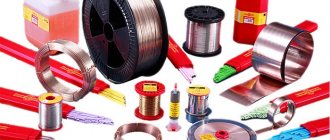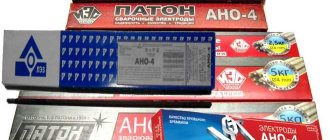Connecting metal structures by welding is the most common method in construction, instrument making, and production of machines and mechanisms.
In the welding process, two surfaces are joined after the base metal is melted by heat. An additional welding element is used, which forms a weld or surfacing after cooling and crystallization. The welding material is introduced into the workspace using a consumable, current-carrying, non-consumable electrode or gas welding. In the process of work, welding materials perform work: when melting, moving in an arc, being in a bath, solidifying, they protect the molten metal; alloy and deoxidize the metal, adjusting the chemical composition of steels; remove oxides, slag, phosphorus and sulfur from the weld filling; free the suture mass from nitrogen and hydrogen.
Classification of materials for welding
The large number of materials required for joining metals by welding makes it difficult to accurately classify, but the main welding materials are divided as follows: filler wire for welding and surfacing; for arc welding, piece electrodes; wire and plate electrodes for slag welding; filler additive materials of non-continuous, solid, tubular cross-section; filler drawn, rolled, drawn cast rods and wire, surfacing strips with powder coating; flammable gas or oxygen; welding equipment, compressor; gas cylinders; a generator for producing acetylene from calcium carbide or an acetylene cylinder under pressure; reducer to reduce welding gas pressure; torches for welding, hardening, surfacing with a set of necessary types of tips of different diameters; rubber hoses for moving oxygen; fluxes and powders for welding.
Melting wires, plates and rods
This type of electrode is used for gas-shielded, submerged arc, and electroslag welding. Steel wire, as a welding material, is divided into high-alloy, low-carbon and alloy. In total, 77 types of similar products are determined by assortment. By selecting the required brands, the chemical composition of the seam is changed. Typically, a wire composition similar to the metal being welded is used. The characteristics of the welding material must comply with GOST and are indicated on the packaging.
Alloy and low-carbon steels for the manufacture of wire are divided into copper-plated and non-copper-plated. For manual welding, wire is used, chopped into pieces ranging from 360 to 400 mm in length. Supplied to the consumer in skeins weighing from 20 to 85 kg. All coils are equipped with labels indicating the manufacturer and technical parameters of the wire.
The plates are used for electroslag welding. Manual arc welding is performed using a specially coated metal electrode rod called an electrode. Electrodes are divided depending on the thickness and composition of the applied layer and the quality of workmanship. Depending on the thickness, there are particularly thick, medium and thin coatings.
Three groups in GOST serve to divide electrodes depending on the accuracy of manufacture and the content of sulfur and phosphorus in the coating composition. The type of welding material coated with stabilizing, binding, deoxidizing, and alloying components is indicated by the letters:
- coating with acid additives – A;
- the main classic option is B;
- coating with the addition of cellulose - C;
- mixed materials in the surface layer – P.
Implementation methods
The complete list of functions performed by auxiliary welding materials is as follows:
- maintaining a true and stable arc discharge;
- blocking oxygen contained in the surrounding air;
- providing data on the characteristics of the welding process itself and the parameters of the metals being processed.
Let us consider how the features of each of the listed welding materials are related to the features of its implementation.
Electrodes
The main purpose of these essential components of the welding process is to supply an electronic current of one form or another and polarity to the welding zone and provide criteria for melting the alloy.
According to their design features, electrodes are divided into iron or non-metallic “consumables”. Products based on an iron base are made of steel, tungsten and other non-ferrous metals (copper, bronze and similar), and non-metallic ones are coated with non-melting coal and graphite components.
The second type of electrodes (they are also called coated) is usually used when organizing manual welding of workpieces, and high-alloy or carbon steel is used as a rod.
Any variety of electrode materials must ensure not only stable combustion in the welding zone, but also insulation of the weld pool from atmospheric oxygen, and also reduce the effect of spattering of alloy particles.
Wire
Wire materials of the so-called “solid” type are used for the manufacture and creation of special consumable electrodes and filler rods and can be used both in automatic and semi-automatic welding modes.
The chemical composition and main standard size (diameter) of the welding wire is determined by the width of the workpieces being welded and the chemical properties of the alloy. Another type of these products is called “powder” and looks like a tube filled inside with a dusty substance. The powder filling the internal cavities performs a function similar to the coating on electrode rods.
Welding gaseous materials (argon, carbon dioxide, helium and oxygen) are used both individually and in mixtures. In the first case, they provide isolation of the weld pool from the oxygen contained in the environment, and in the 2nd case, they help to increase the properties of the weld (increase its mechanical and strength characteristics).
Special clay linings began to be used in welding not so long ago, but they have already proven themselves to be the best. The advantages of these auxiliary devices include the versatility of their implementation, which allows them to be used in virtually all welding operations.
Non-consumable welding rods and electrodes for machine welding
To connect surfaces in shielding gases, special welding materials are used. The definition of such welding is given as a process that uses an electric arc between an electrode and a surface as a heat source. Round tungsten electrodes with a diameter of 5-10 mm supply electric current to the arc area. Pure tungsten is used as a material or additives of lanthanum, yttrium, and sodium dioxide oxides are added. Tungsten itself cannot be replaced with a cheaper metal, since it is the most refractory, with a high boiling point (5900 ºC) and is used for welding with direct and alternating current.
Welding materials: systematization and properties
When welding products, welding materials are used. They allow for a measured arc burning, pore-free welds that are resistant to damage. Their systematization and purpose will be presented below.
Welding materials do the following functions:
- ensure stability of the welding process;
- remove harmful impurities from the weld alloy;
- ensure the correct geometric dimensions of the seams;
- ensure the production of weld material with a certain chemical composition and qualities;
- help protect the molten alloy from air.
Application of oxygen
Oxygen is heavier than air, it promotes the combustion of gases and vapors at high speed, which releases heat and reaches a high melting point. The interaction of compressed oxygen with fatty oils and lubricants leads to spontaneous ignition and explosion, so work with oxygen cylinders is carried out in clean conditions, without the danger of such contamination. Storage of oxygen-type welding materials is carried out in compliance with fire safety standards.
Oxygen for welding is technical, obtained from the atmosphere. The air is processed in special separation devices, carbon dioxide impurities are removed, and the final product is dried. Liquid oxygen for transportation and storage requires special containers with increased thermal insulation.
Use of acetylene
Acetylene is a compound of oxygen and hydrogen. This flammable gas is in a gaseous state at normal temperatures. The colorless gas contains impurities of ammonia and hydrogen sulfide. The flammable component of the material is dangerous. Welding pressure of more than 1.5 kgf/cm2 or accelerated heating to 400 ºС is enough to cause an explosion. Gas is produced by an electric arc discharge, which promotes the separation of liquid flammable components or by the decomposition of calcium carbide under the influence of moisture.
Systematization of welding materials
So , what groups are these materials divided into:
Interesting read: How to assemble a welding helmet?
- electrodes and filler rods - these include electrodes with acidic, cellulose, mixed, rutile, main and other coatings, as well as non-consumable electrodes;
- wire - can be activated, powdered or solid;
- fluxes - divided into electrically conductive and protective;
- gases - to support combustion, protective, which are active and inert, and flammable;
- clay lining - used for joining butt, corner and T-seams, they can be all-position, round, etc.
Electrodes and wires
Wires and electrodes are necessary to provide electrical power to the welding area for heating purposes. Coated consumable electrodes, certain types of wire and protective flux for arc welding contain special components that can protect the alloy from the action of air, maintain the stability of the work process and help obtain a certain chemical composition of the weld alloy and more. And the filler rod is introduced into the seam during welding.
Melting wires are used in work in the following situations:
- submerged;
- in protective gases;
- during electroslag welding.
There are 3 types of iron wires:
- alloyed;
- highly alloyed;
- low carbon.
In total there are 77 varieties in the assortment.
When choosing one or another brand, the chemical composition of the weld changes. Most often they use wire whose composition resembles the alloy that is being processed. The material must comply with GOST and be indicated on the product packaging.
In turn, low-carbon and alloy steel for wire production can be copper-plated or non-copper-plated. For manual welding, wire is used, which is cut into pieces 360-400 mm in length. You can buy it in skeins weighing 20−85 kg. Any such skein has a label indicating the manufacturer and technical characteristics of the product.
It is forbidden to use wire of unknown manufacture or unknown brand for work . The surface of the filler wire must be smooth and free from grease, rust or scale. It must be selected according to its melting index; it must be lower than the similar properties of the materials being joined.
One of the high-quality parameters of the wire is its ability to melt evenly, without sudden splashes. If there is no special wire for joining products made of stainless steel, brass, lead or copper, then use strips of cut alloy from the same material that is being welded.
Plates and rods
The plates are used for electroslag welding, and arc welding is carried out using an electrode iron rod with a coating on the base of the electrode. There are 3 types of electrode thickness:
- thick;
- average;
- narrow.
The type of welding material with different coatings is indicated by signs as follows:
- A - the coating has acid additives;
- B - traditional option;
- C - the coating contains cellulose;
- P - there are mixed materials in the surface layer.
When cutting and gas welding, flammable gases and those that support combustion are used. These include:
- oxygen;
- acetylene;
- hydrogen;
- propane-butane mixture;
- methylacetylene allene fraction.
Shielding gases are provided to provide gas protection of the molten material from air. Shielding gases are:
- inert (helium, argon and mixtures based on them);
- active (carbon dioxide and consistencies based on it).
An inert gas cannot enter into a chemical reaction with an alloy and practically does not dissolve in it, but active gases can enter into such a reaction and dissolve in alloys.
As for oxygen , it is heavier than air and helps gases and vapors burn very quickly, while at the same time heat can be released, and the melting point is the highest. With all this, compressed oxygen, when combined with lubricants and fatty oils, can lead to an explosion and spontaneous ignition; accordingly, you should work with oxygen cylinders only in clean conditions, where this is excluded. Oxygen-type welding materials must be stored only in compliance with fire safety standards.
Interesting read: How to choose an argon welding machine?
Welding oxygen is technical, it comes out of the atmosphere. And at the same time, the air is processed in a separation apparatus, as a result, carbon dioxide impurities are removed, and the finished product is dried. In watery form, oxygen for storage and transportation is contained in special containers that have the highest thermal insulation.
Another gas, acetylene , is oxygen combined with hydrogen. At ordinary temperatures, acetylene is in a gaseous state. It is dull and contains impurities of hydrogen sulfide and ammonia. The danger is posed by the flammable components of such a material; welding pressure from 1.5 kgf/cm2 or accelerated heating to a temperature of 400 degrees can also lead to an explosion.
The gas is made by means of an electric arc discharge, which divides the watery flammable components, or through the decomposition of calcium carbide under the influence of water.
There are also acetylene substitutes . According to the requirements for materials for welding work, liquid vapors and other materials may be used. They are used if the heating temperature is twice the melting index of the alloy.
In order for one or another type of gas to burn, a certain amount of oxygen is needed in the burner. These or other flammable substances are used instead of acetylene, since they are cheap and easy to obtain. They can be used in various industrial fields, but the use of such substances is limited due to their relatively low heating limit.
Fluxes for welding and other materials
Flux has different purposes in the welding process. Thanks to it, it is possible to dissolve oxides on the surface of the alloy, which helps facilitate the process of wetting the workpiece with the molten alloy. Flux also acts as a barrier to oxygen, acting as a coating on the hot surface of the workpiece, and prevents oxidation of the alloy. The flux melt can also act as a heat exchange medium, facilitating heating of the joint.
Fluxes differ from each other according to the following characteristics:
- production method;
- purpose;
- own chemical composition and other characteristics.
For example, depending on the production method, they are either fused or unfused. Fused fluxes are made by fusing parts of the charge in furnaces. But the unfused parts of the flux charge can be held together without fusion.
Flux consists of a powder or paste of a certain composition; it is created on the basis of boric acid or calcined borax. Fluxes are not used to join alloy steels.
And another type of material for welding, a clay lining, is used to make a high-quality seam and form a reverse bead.
All of the listed welding materials can also be divided according to the type of metals and steels being welded. For example, some are intended for joining carbon steels, others - for stainless or low-alloy steels or cast iron, copper and other materials.
Gas substitutes for acetylene
Requirements for welding materials allow the use of liquid vapors and other gases for work. They are used if the heating temperature exceeds twice the melting rate of the metal. For the combustion of different types of gases, one or another amount of oxygen entering the burner is required. Combustible substances are used instead of acetylene because of their low cost and the possibility of widespread production. They are used in various industries, but the use of substitutes is limited by their relatively low heating range.
Wire and welding fluxes
Unknown wire of an unidentified brand is not used for welding. The surface of the filler wire is smooth, free of rust, scale, and grease. It is selected according to the melting index, which is lower than this characteristic of the steels being welded. One of the quality properties of the wire is its gradual melting without sudden splashes. As an exception, if the required wire is not available, for welding brass, lead, copper, and stainless steel, strips of cut metal from the same material that is being joined are used. When welding metals such as aluminum, magnesium, copper, brass, cast iron, active interaction of non-ferrous castings with oxygen from the atmosphere or an oxidizing flame occurs. The reaction leads to the formation of oxides with a high melting point, which create a harmful film and make it difficult for the substance on the surface to transition to a liquid state. A welding material called flux, consisting of a paste or powder of the appropriate composition, is used to protect the surface of the molten mass. The material is boric acid, calcined borax. Fluxes are not used when welding alloy steels.
Flow Estimate
To minimize production costs when welding workpieces, it is important to calculate the costs of the material used for certain purposes.
It is also important that for the latter option it is better to have in your personal storage the necessary supply of electrodes of different brands, various fluxes, welding wire and inert gases. Interesting to read: The principle of operation of welding machines The approximate calculation of the required amount of welding consumables is based on the working standards for their use, taking into account the characteristics of a particular type of welding.
The rate of use is understood as a quantitative indicator by which one can judge the intensity of consumption of these materials, taking into account probable non-production losses (rejection) and waste. This indicator includes costs at the stage of preliminary and main work, as well as costs associated with eliminating defects.
Consumption rationing involves taking into account each type of weld and methods of welding metals separately and evaluating them based on the belief of saving material.
With all this, the inevitable losses in any welding process are certainly taken into account, which are also usually standardized depending on the welding criteria and the complexity of the structure being processed.
Specialists use well-known formulas to calculate the required volume of auxiliary materials, which allow them to roughly estimate the value of this indicator.
According to these calculations, the indicator of the costs of materials used in welding is taken to be their costs per unit length of the weld. In addition, the formulas take into account properties such as cross-sectional area and specific gravity of the alloy being processed.
Safety water seals
The device for protecting the rubber pipeline and the gas generator from the return of backfire from the burner is called a shutter. The requirements for welding materials determine that the water seal is designed in such a way that it prevents the oxygen or acetylene mass in the hole of the torch or cutter from igniting. A water seal is necessarily included in the equipment; this is a fire safety requirement that must be met. The valve is placed in the space between the cutter and the burner; according to the instructions, it is in good condition and is periodically filled with water to the required level. This device is the main one in the chain of welding equipment.
Cylinders for storing compressed gases
Cylinders are made in the form of cylindrical steel vessels. The conical hole in the neck area is closed with a shut-off valve on the thread. The cylinder walls are connected using a seamless method; the material is alloy and carbon steel. External coloring makes it possible to recognize the type of gas placed inside. Oxygen is transported in blue vessels, acetylene cylinders are painted white, the yellow-green tint indicates the hydrogen content, and other flammable gases are placed in red containers.
The passport data of the gas is written on the top of the cylinder. The requirement for storing welding materials requires that the cylinders be installed vertically and secured to the wall with a clamp. The valves of oxygen storage cylinders are made of brass; the use of steel is not permitted due to the corrosion of materials in a gas environment. The taps of acetylene gas cylinders are made of steel; it is prohibited to use copper and an alloy with a copper content of more than 70%. Acetylene reacts with copper to form an explosive mixture.
Classification of steels by weldability
When assessing weldability, the role of the chemical composition of the steel is predominant. Using this indicator, as a first approximation, weldability is assessed. The influence of the main alloying impurities on the weldability of steels is given below.
Carbon (C) is one of the most important impurities that determines the strength, ductility, hardenability and other characteristics of steel. Carbon content in steels up to 0.25% does not reduce weldability. A higher “C” content leads to the formation of hardening structures in the metal of the heat-affected zone (hereinafter referred to as the HAZ) and the appearance of cracks.
Sulfur (S) and phosphorus (P) are harmful impurities. An increased content of “S” leads to the formation of hot cracks – red brittleness, and “P” causes cold brittleness. Therefore, the content of “S” and “P” in low-carbon steels is limited to 0.4÷0.5%.
Silicon (Si) is present in steels as an impurity in amounts up to 0.3% as a deoxidizing agent. With this “Si” content, the weldability of steels does not deteriorate. As an alloying element, with a “Si” content of up to 0.8÷1.0% (especially up to 1.5%), the formation of refractory “Si” oxides is possible, which impairs weldability.
Manganese (Mn) content in steel is up to 1.0% - the welding process is not difficult. When welding steels with a Mn content of 1.8÷2.5%, hardening structures and cracks may appear in the HAZ metal.
Chromium (Cr) in low carbon steels is limited as an impurity to 0.3%. In low-alloy steels, chromium content is possible in the range of 0.7÷3.5%. In alloy steels its content ranges from 12% to 18%, and in high-alloy steels it reaches 35%. When welding, chromium forms carbides, which impair the corrosion resistance of steel. Chromium promotes the formation of refractory oxides, which complicate the welding process.
Nickel (Ni) , similar to chromium, is found in low-carbon steels in amounts up to 0.3%. In low-alloy steels its content increases to 5%, and in high-alloy steels – up to 35%. In nickel-based alloys, its content is prevalent. Nickel increases the strength and plastic properties of steel and has a positive effect on weldability.
Vanadium (V) in alloy steels is contained in an amount of 0.2÷0.8%. It increases the toughness and ductility of steel, improves its structure, and helps increase hardenability.
Molybdenum (Mo) in steels is limited to 0.8%. At this content, it has a positive effect on the strength properties of steel and refines its structure. However, during welding it burns out and contributes to the formation of cracks in the deposited metal.
Titanium and niobium (Ti and Nb) in corrosion-resistant and heat-resistant steels are contained in amounts up to 1%. They reduce the sensitivity of steel to intergranular corrosion, however, niobium in steels of type 18-8 promotes the formation of hot cracks.
Copper (Cu) is contained in steels as an impurity (in amounts up to 0.3% inclusive), as an additive in low-alloy steels (0.15 to 0.5%) and as an alloying element (up to 0.8÷1%). It increases the corrosion properties of steel without compromising weldability.
When assessing the influence of the chemical composition on the weldability of steel, in addition to the carbon content, the content of other alloying elements that increase the susceptibility of steel to hardening is also taken into account. This is achieved by recalculating the content of each alloying element of steel in the equivalent effect on its hardenability using conversion factors determined experimentally. The total content of carbon and recalculated equivalent amounts of alloying elements in steel is called carbon equivalent. To calculate it, there are a number of formulas compiled using various methods that allow you to evaluate the influence of the chemical composition of low-alloy steels on their weldability:
SEKV = C + Mn/6 + Cr/5 + Mo/5 + V/5 + Ni/15 + Cu/15 (MIS method);
SEKV = C + Mn/6 + Si/24 + Ni/40 + Cr/5 + Mo/4 (Japanese method);
[C]X = C + Mn/9 + Cr/9 + Ni/18 + 7Mo/90 (Seferian method),
where the numbers indicate the content in steel in mass fractions of a percent of the corresponding elements.
Each of these formulas is acceptable only for a certain group of steels, however, the carbon equivalent value can be used when solving practical issues related to the development of welding technology. Quite often, calculations of the chemical carbon equivalent for carbon and low-alloy structural steels of the pearlitic class are performed using the Seferian formula.
According to weldability, steels are conventionally divided into four groups: well weldable, satisfactory weldable, limited weldable, poorly weldable (Table 1.1).
The first group includes the most common grades of low-carbon and alloy steels ([C]X≤0.38), welding of which can be performed using conventional technology, i.e. without heating before welding and during the welding process, as well as without subsequent heat treatment. It is recommended to weld cast parts with a large volume of deposited metal with intermediate heat treatment. For structures operating under static loads, heat treatment after welding is not performed. For critical structures operating under dynamic loads or high temperatures, heat treatment is recommended
The second group includes carbon and alloy steels ([C]x=0.39÷0.45), when welded under normal production conditions, cracks do not form. This group includes steels that must be preheated to prevent the formation of cracks and also subjected to subsequent heat treatment. Heat treatment before welding is different and depends on the grade of steel and the design of the part. For castings made of 30L steel, annealing is required. Machine parts made from rolled products or forgings that do not have rigid contours can be welded in a heat-treated state (hardening and tempering). Welding at ambient temperatures below 0°C is not recommended. Welding of parts with a large volume of deposited metal is recommended to be carried out with intermediate heat treatment (annealing or high tempering)
Table 1. Classification of steels by weldability.
| Weldability group | GOST | steel grade |
| Well weldable | 380-94* | Low carbon St1÷St4 (kp, ps, sp) |
| 1050-88 | 08÷25 (kp, ps) | |
| 803-81 | 11YuA, 18YuA | |
| 4041-71 | 08Yu, 25ps | |
| Well weldable | 5520-79 | 15K, 16K, 18K, 20K, 22K |
| 5521-93 | A, A32, A36, A40, B, D, D32, D36, D40, E, E32, E36, E40 | |
| 5781-82 | 10GT | |
| 977-88 | 15L, 20L, 25L | |
| 4543-71 | Low alloy 15G, 20G, 25G, 10G2, 12ХН, 12ХН2, 15Н2М, 15Х, 15ХА, 20Х, 15ХФ, 20Н2М | |
| 19281-89 | 09G2, 09G2S, 09G2D, 10G2B, 10G2BD, 12GS, 16GS, 17GS, 17G1S, 10G2S1,09G2SD, 10G2S1D, YuHSND, YuKHNDP, 14G2AF, 14G2AFD, 15GFD, 15HSND | |
| 977-88 | 08GDNFL, 12DN2FL, 13ХДНФТЛ | |
| Satisfactorily weldable | 380-94* | Carbon steel St5 (ps, sp), St5Gps |
| 1050-88 | 30 | |
| 977-75 | 30L | |
| 4543-71 | Alloyed 16KhG, 18KhGT, 14KhGN, 19KhGN, 20KhGSA, 20KhGR, 20KhN, 20KhNR, 12KhN3A, 20KhN2M | |
| 19281-89 | 15G2AFDps, 16G2AFD, 15G2SF, 15G2SFD | |
| 10702-78** | 20G2S | |
| 5781-82 | 18G2S, 25G2S | |
| 977-88 | 20GL, 20GSL, 20FL, 20G1FL, 20DHL, 12DHN1MFL | |
| Limited weldability | 380-94* | Carbon steel St5 (ps, sp), St5Gps |
| 1050-88 | 35, 40, 45 | |
| 977-88 | 35L 40L, 45L | |
| 4543-71 | Alloyed 25ХГСА, 29ХН3А, 12Х2Н4А, 20Х2Н4А, 20ХН4А, 25ХГМ, 35G, 35G2, 35Х, 40Х, 33ХС, 38ХС, 30ХГТ, 30ХРА, 30ХГС, 30ХГСА, 35ХГСА, 25ХГНМТ , 30ХГНЗА, 20Х2Н4А | |
| 11268-76 | 12X2NVFA | |
| 977-88 | 35GL, 32H06L, 45FL, 40HL, 35HGSL, 35NGML, 20HGSNDML, 30HGSFL, 23HGS2MFL | |
| Poorly welded | 1050-88 | Carbon 50, 55 |
| 977-88 | 50L, 55L | |
| 4543-71 | Alloyed 50G, 45G2, 50G2, 45Х, 40ХС, 50ХГ, 50ХГА, 50ХН, 55С2, 55С2А, 30ХГСН2А, etc. | |
| 11268-76 | 23Х2NVFA | |
| 10702-78** | 38ХГНМ | |
| 5950-2000 | 9X, 9X1 | |
| 977-88 | 30ХНМЛ, 25Х2Г2ФЛ | |
| 1435-99 | У7÷У13А | |
| *DSTU 2651-94 (GOST 380-94). ** Canceled in Ukraine. | ||
In cases where subsequent tempering is impossible, the welded part is subjected to local heating. Heat treatment after welding is different for different grades of steel. When welding small defects in steel containing more than 0.35% carbon, heat treatment (annealing or high temperature tempering for this steel) is necessary to improve the mechanical properties and workability.
The third group includes carbon and alloy steels ([C]X = 0.46÷0.59) of the pearlitic class, which are prone to crack formation under normal welding conditions. The weldability of this group of steels is ensured by using special technological measures, consisting of their preliminary heat treatment and heating. In addition, most products from this group of steels are subjected to heat treatment after welding. For parts and castings made from rolled products or forgings that do not have particularly rigid contours and rigid components, welding in a heat-treated state (quenching and tempering) is allowed.
Without preheating, such steels can be welded in cases where the joints do not have rigid contours, the metal thickness is no more than 14 mm, the ambient temperature is not lower than +5 ° C and the joints being welded are of an auxiliary nature. In all other cases, preheating to a temperature of 200°C is required.
Heat treatment of this group of steels is assigned according to the mode selected for a specific steel.
The fourth group includes carbon and alloy steels ([C]x≥0.60) of the pearlitic class, which are the most difficult to weld and are prone to cracking. When welding this group of steels using rational technologies, the required performance properties of welded joints are not always achieved. These steels are weldable to a limited extent, so their welding is performed with mandatory preliminary heat treatment, with heating during the welding process and subsequent heat treatment. Before welding, such steel must be annealed. Regardless of the thickness and type of connection, the steel must be preheated to a temperature of at least 200°C. Heat treatment of the product after welding is carried out depending on the grade of steel and its purpose.
The operational reliability and durability of welded structures made of low-alloy heat-resistant steels depends on the maximum permissible operating temperature and the long-term strength of welded joints at this temperature. These indicators are determined by the alloying system of heat-resistant steels. According to the alloying system, steels can be divided into chromium-molybdenum, chromium-molybdenum-vanadium and chromium-molybdenum-tungsten (Table 1.2). In these steels, the value of the carbon equivalent varies within wide limits and assessing the weldability of steels based on its value is impractical. Calculation of the preheating temperature is performed for each specific steel grade.
The division of high-alloy steels into groups (stainless, acid-resistant, heat-resistant and heat-resistant) within the framework of GOST 5632-72 is made conditionally in accordance with their main service characteristics, since heat-resistant and heat-resistant steels are at the same time acid-resistant in certain aggressive environments, and acid-resistant steels are both heat-resistant and heat resistance at certain temperatures.
Let us dwell on brief recommendations on the technology of welding high-alloy steels, which, as already noted, are divided into four groups.
For highly weldable high-alloy steels, heat treatment before and after welding is not carried out. With significant hardening, the metal must be hardened from 1050÷1100°C. The thermal conditions of welding are normal. This group of steels includes a number of acid-resistant and heat-resistant steels with an austenitic and austenitic-ferritic structure.
For satisfactorily weldable high-alloy steels, a preliminary tempering at 650÷710°C with air cooling is recommended before welding. The thermal conditions of welding are normal. At negative temperatures, welding is not allowed. Preheating to 150÷200°C is necessary when welding structural elements with a wall thickness of more than 10 mm. After welding, to relieve stress, it is recommended to temper at 650÷710°C. This group primarily includes most chromium and some chromium-nickel steels.
Table 2. Grades of heat-resistant and high-alloy steels and alloys based on iron-nickel and nickel.
| Class | GOST or TU | steel grade |
| Pearlitic or martensitic | GOST4543-71 | Heat-resistant chrome-molybdenum 15ХМ, 20ХМ, 30ХМ, 30ХМА, 35ХМ, 38ХМ, 38Х2МУА |
| TU108-1028-81 | 34ХМА | |
| GOST20072-74 | 12МХ, 15Х5М, 15X5 | |
| GOST5520-79 | 12ХМ, 10Х2М, 10Х2М-ВД | |
| GOST977-88 | 35HML | |
| TU5.961-11.151-80 | 20HML | |
| GOST4543-71 | Heat-resistant chrome-molybdenum-vanadium and chrome-molybdenum-tungsten 40ХМФА, 30ХЗМФ | |
| GOST20072-74 | 20Х1М1Ф1БР, 12Х1МФ, 25Х1МФ, 25Х2М1Ф, 20Х1М1Ф1ТР, 18ХЗМВ, 20ХЗИВФ, 15Х5ВФ | |
| TU14-1-1529-76 | 15Х1М1Ф TU14-1-3238-81, 35ХМФА | |
| TU108.131-86 | 12X2MFA, 18X2MFA, 25X2MFA | |
| TU14-1-1703-76 | 38ХМФУА | |
| TU5.961-11151-80 | 20ХМФЛ, 15Х1М1ФЛ | |
| Ferritic, martensitic-ferritic and martensitic | GOST5632-72 | High chromium stainless steel 08X13, 12X13, 20X13, 30X13, 40X13, 25X13H2 |
| TU108-976-80 | 10X12ND | |
| GOST5632-72 | High -grown acid -resistant and heat -resistant 12x17, 08x17t, 09x16N4B, 30X13N7C2, 08x18T1, 15x18Su, 15x25t, 15x28, 14x17N2, 20x17N2, 10x13Su, 40x9C2, 40x10S2M2M | |
| TU 14-1-2889-80 | 09Х17НВД | |
| TU14-1-1958-77 | 11Х17Н | |
| TU14-1-2533-78 | 10X17Yu3B | |
| GOST5632-72 | High-chromium heat-resistant 15Х11МФ, 18Х11МНФБ, 20Х12ВНМФ, 11Х11Н2В2МФ, 13Х11Н2В2МФ, 13Х14НЗВ2ФР, 15Х12ВНМФ, 18Х12ВМБФР | |
| TU14-3-450-75 | 12Х11В2МФ | |
| Austenitic and austenitic-ferritic | GOST5632-72 | Acid-resistant 04Х18Н10, 08Х18Н10, 08Х18Н10Т, 12Х18Н9, 12Х18Н9Т, 17Х18Н9, 12Х18Н10Т, 12Х18Н10Б, 03Х18Н11, 08Х18Н12Б, 03Х17Н14М2, E8Х17 Н13М2Т, 10Х17Н13М2Т, 10Х13МЗТ, 08Х17Н15МЗТ, 08Х18Н12Т, 08Х10Н20Т2, 10Х14Г14НЗ, 10Х14Г14Н4Т, 10Х14AG15, 15Х17AG14, 07Х21G7AN5, 03 Kh21N21M4GB, 12Kh17G9AN4, 08Kh18G8N2T , 15Х18Н12С4ТУ |
| TU108.11.595-87 | 03Х16Н9М2 | |
| Austenitic marten-sieve | GOST5632-72 | 07Х16Н6, 09Х17Н7У, 09Х17Н7УТ, 08Х17Н5МЗ, 08Х17Н6Т, 09Х15Н8У, 20Х13Н4Г9 |
| Ferritic-austenitic | GOST5632-72 | High-strength acid-resistant 08Х22Н6Т, 12Х21Н5Т.08Х21Н6 |
| TU14-1-1958-77 | 10Х25Н6АТМФ | |
| Ferritic-austenitic | GOST977-88 | 12Х25Н5ТМФЛ |
| TU14-1-1541-75 | 03Х23Н6, 03Х22Н6М2 | |
| Austenitic | GOST5632-72 | Heat-resistant 20Х23Н13, 10Х23Н18, 20Х23Н18, 08Х20Н14С2, 20Х20Н14С2, 20Х25Н20С2, 12Х25Н16G7AR, 36Х18Н25С2, 45Х22Н4МЗ, 55Х20Г9AN4 |
| Iron-nickel and nickel-based alloys | GOST5632-72 | KhN38VT, KhN60Yu, KhN70Yu, KhN78T |
| Austenitic | GOST5632-72 | Heat-resistant 10Х11Н20ТЗР, 10Х11Н23ТЗМР, 08Х16Н13М2Б, 09Х16Н15МЗБ, 08Х15Н24В4ТР, 31Х19Н9МВБТ, 10Х11Н20ТЗР, 37Х12Н8Г8МФБ, 45Х14Н14В2М, 09X14N19V2BR, 09X14N19V2BR1, 40X15N7G7F2MS, 09X14N16B |
| Iron-nickel and nickel-based alloys | GOST5632-72 | KhN35VT, KhN35VTYu, KhN32T, KhN38VT, KhN80TBYu, KhN67MVTYu |
For limited weldable high-alloy steels, heat treatment before welding is different (tempering at 650÷710°C with air cooling or quenching in water from 1050÷1100°C). When welding most steels of this group, preheating to 200÷300°C is required.
After welding, to relieve stress and reduce hardness, parts of the welded joint are subjected to tempering at 650÷710°C. To weld a number of austenitic steels, quenching in water from 1050÷1100°C is required.
For poorly weldable high-alloy steels, tempering under certain conditions for various steels is recommended before welding.
For the entire group of steels, preheating to 200÷300°C is required. Welding of steel 110G13L in the hardening state is carried out without heating. Heat treatment after welding is carried out according to special instructions, depending on the steel grade and purpose. For steel 110G13L, heat treatment is not required.
Preparing metal for welding
When preparing parts for welding, the incoming metal is subjected to straightening, marking, marking, cutting, preparing edges for welding, cold or hot bending.
Before welding, the base metal and filler material must be thoroughly cleaned of rust, oil, moisture, scale and various types of non-metallic inclusions. In place of the indicated contaminants, it leads to the formation of steam, cracks, and slag inclusions in the welds, which leads to a decrease in the strength and density of the welded joint.
When assessing weldability, the role of the chemical composition of the steel is predominant. Using this indicator, as a first approximation, weldability is assessed. The influence of the main alloying impurities on the weldability of steels is given below.
Carbon (C) is one of the most important impurities that determines the strength, ductility, hardenability and other characteristics of steel. Carbon content in steels up to 0.25% does not reduce weldability. A higher “C” content leads to the formation of hardening structures in the metal of the heat-affected zone (hereinafter referred to as the HAZ) and the appearance of cracks.
Sulfur (S) and phosphorus (P) are harmful impurities. An increased content of “S” leads to the formation of hot cracks – red brittleness, and “P” causes cold brittleness. Therefore, the content of “S” and “P” in low-carbon steels is limited to 0.4÷0.5%.
Silicon (Si) is present in steels as an impurity in amounts up to 0.3% as a deoxidizing agent. With this “Si” content, the weldability of steels does not deteriorate. As an alloying element, with a “Si” content of up to 0.8÷1.0% (especially up to 1.5%), the formation of refractory “Si” oxides is possible, which impairs weldability.
Manganese (Mn) content in steel is up to 1.0% - the welding process is not difficult. When welding steels with a Mn content of 1.8÷2.5%, hardening structures and cracks may appear in the HAZ metal.
Chromium (Cr) in low carbon steels is limited as an impurity to 0.3%. In low-alloy steels, chromium content is possible in the range of 0.7÷3.5%. In alloy steels its content ranges from 12% to 18%, and in high-alloy steels it reaches 35%. When welding, chromium forms carbides, which impair the corrosion resistance of steel. Chromium promotes the formation of refractory oxides, which complicate the welding process.
Nickel (Ni) , similar to chromium, is found in low-carbon steels in amounts up to 0.3%. In low-alloy steels its content increases to 5%, and in high-alloy steels – up to 35%. In nickel-based alloys, its content is prevalent. Nickel increases the strength and plastic properties of steel and has a positive effect on weldability.
Vanadium (V) in alloy steels is contained in an amount of 0.2÷0.8%. It increases the toughness and ductility of steel, improves its structure, and helps increase hardenability.
Molybdenum (Mo) in steels is limited to 0.8%. At this content, it has a positive effect on the strength properties of steel and refines its structure. However, during welding it burns out and contributes to the formation of cracks in the deposited metal.
Titanium and niobium (Ti and Nb) in corrosion-resistant and heat-resistant steels are contained in amounts up to 1%. They reduce the sensitivity of steel to intergranular corrosion, however, niobium in steels of type 18-8 promotes the formation of hot cracks.
Copper (Cu) is contained in steels as an impurity (in amounts up to 0.3% inclusive), as an additive in low-alloy steels (0.15 to 0.5%) and as an alloying element (up to 0.8÷1%). It increases the corrosion properties of steel without compromising weldability.
When assessing the influence of the chemical composition on the weldability of steel, in addition to the carbon content, the content of other alloying elements that increase the susceptibility of steel to hardening is also taken into account. This is achieved by recalculating the content of each alloying element of steel in the equivalent effect on its hardenability using conversion factors determined experimentally. The total content of carbon and recalculated equivalent amounts of alloying elements in steel is called carbon equivalent. To calculate it, there are a number of formulas compiled using various methods that allow you to evaluate the influence of the chemical composition of low-alloy steels on their weldability:
SEKV = C + Mn/6 + Cr/5 + Mo/5 + V/5 + Ni/15 + Cu/15 (MIS method);
SEKV = C + Mn/6 + Si/24 + Ni/40 + Cr/5 + Mo/4 (Japanese method);
[C]X = C + Mn/9 + Cr/9 + Ni/18 + 7Mo/90 (Seferian method),
where the numbers indicate the content in steel in mass fractions of a percent of the corresponding elements.
Each of these formulas is acceptable only for a certain group of steels, however, the carbon equivalent value can be used when solving practical issues related to the development of welding technology. Quite often, calculations of the chemical carbon equivalent for carbon and low-alloy structural steels of the pearlitic class are performed using the Seferian formula.
According to weldability, steels are conventionally divided into four groups: well weldable, satisfactory weldable, limited weldable, poorly weldable (Table 1.1).
The first group includes the most common grades of low-carbon and alloy steels ([C]X≤0.38), welding of which can be performed using conventional technology, i.e. without heating before welding and during the welding process, as well as without subsequent heat treatment. It is recommended to weld cast parts with a large volume of deposited metal with intermediate heat treatment. For structures operating under static loads, heat treatment after welding is not performed. For critical structures operating under dynamic loads or high temperatures, heat treatment is recommended
The second group includes carbon and alloy steels ([C]x=0.39÷0.45), when welded under normal production conditions, cracks do not form. This group includes steels that must be preheated to prevent the formation of cracks and also subjected to subsequent heat treatment. Heat treatment before welding is different and depends on the grade of steel and the design of the part. For castings made of 30L steel, annealing is required. Machine parts made from rolled products or forgings that do not have rigid contours can be welded in a heat-treated state (hardening and tempering). Welding at ambient temperatures below 0°C is not recommended. Welding of parts with a large volume of deposited metal is recommended to be carried out with intermediate heat treatment (annealing or high tempering)
Table 1. Classification of steels by weldability.
| Weldability group | GOST | steel grade |
| Well weldable | 380-94* | Low carbon St1÷St4 (kp, ps, sp) |
| 1050-88 | 08÷25 (kp, ps) | |
| 803-81 | 11YuA, 18YuA | |
| 4041-71 | 08Yu, 25ps | |
| Well weldable | 5520-79 | 15K, 16K, 18K, 20K, 22K |
| 5521-93 | A, A32, A36, A40, B, D, D32, D36, D40, E, E32, E36, E40 | |
| 5781-82 | 10GT | |
| 977-88 | 15L, 20L, 25L | |
| 4543-71 | Low alloy 15G, 20G, 25G, 10G2, 12ХН, 12ХН2, 15Н2М, 15Х, 15ХА, 20Х, 15ХФ, 20Н2М | |
| 19281-89 | 09G2, 09G2S, 09G2D, 10G2B, 10G2BD, 12GS, 16GS, 17GS, 17G1S, 10G2S1,09G2SD, 10G2S1D, YuHSND, YuKHNDP, 14G2AF, 14G2AFD, 15GFD, 15HSND | |
| 977-88 | 08GDNFL, 12DN2FL, 13ХДНФТЛ | |
| Satisfactorily weldable | 380-94* | Carbon steel St5 (ps, sp), St5Gps |
| 1050-88 | 30 | |
| 977-75 | 30L | |
| 4543-71 | Alloyed 16KhG, 18KhGT, 14KhGN, 19KhGN, 20KhGSA, 20KhGR, 20KhN, 20KhNR, 12KhN3A, 20KhN2M | |
| 19281-89 | 15G2AFDps, 16G2AFD, 15G2SF, 15G2SFD | |
| 10702-78** | 20G2S | |
| 5781-82 | 18G2S, 25G2S | |
| 977-88 | 20GL, 20GSL, 20FL, 20G1FL, 20DHL, 12DHN1MFL | |
| Limited weldability | 380-94* | Carbon steel St5 (ps, sp), St5Gps |
| 1050-88 | 35, 40, 45 | |
| 977-88 | 35L 40L, 45L | |
| 4543-71 | Alloyed 25ХГСА, 29ХН3А, 12Х2Н4А, 20Х2Н4А, 20ХН4А, 25ХГМ, 35G, 35G2, 35Х, 40Х, 33ХС, 38ХС, 30ХГТ, 30ХРА, 30ХГС, 30ХГСА, 35ХГСА, 25ХГНМТ , 30ХГНЗА, 20Х2Н4А | |
| 11268-76 | 12X2NVFA | |
| 977-88 | 35GL, 32H06L, 45FL, 40HL, 35HGSL, 35NGML, 20HGSNDML, 30HGSFL, 23HGS2MFL | |
| Poorly welded | 1050-88 | Carbon 50, 55 |
| 977-88 | 50L, 55L | |
| 4543-71 | Alloyed 50G, 45G2, 50G2, 45Х, 40ХС, 50ХГ, 50ХГА, 50ХН, 55С2, 55С2А, 30ХГСН2А, etc. | |
| 11268-76 | 23Х2NVFA | |
| 10702-78** | 38ХГНМ | |
| 5950-2000 | 9X, 9X1 | |
| 977-88 | 30ХНМЛ, 25Х2Г2ФЛ | |
| 1435-99 | У7÷У13А | |
| *DSTU 2651-94 (GOST 380-94). ** Canceled in Ukraine. | ||
In cases where subsequent tempering is impossible, the welded part is subjected to local heating. Heat treatment after welding is different for different grades of steel. When welding small defects in steel containing more than 0.35% carbon, heat treatment (annealing or high temperature tempering for this steel) is necessary to improve the mechanical properties and workability.
The third group includes carbon and alloy steels ([C]X = 0.46÷0.59) of the pearlitic class, which are prone to crack formation under normal welding conditions. The weldability of this group of steels is ensured by using special technological measures, consisting of their preliminary heat treatment and heating. In addition, most products from this group of steels are subjected to heat treatment after welding. For parts and castings made from rolled products or forgings that do not have particularly rigid contours and rigid components, welding in a heat-treated state (quenching and tempering) is allowed.
Without preheating, such steels can be welded in cases where the joints do not have rigid contours, the metal thickness is no more than 14 mm, the ambient temperature is not lower than +5 ° C and the joints being welded are of an auxiliary nature. In all other cases, preheating to a temperature of 200°C is required.
Heat treatment of this group of steels is assigned according to the mode selected for a specific steel.
The fourth group includes carbon and alloy steels ([C]x≥0.60) of the pearlitic class, which are the most difficult to weld and are prone to cracking. When welding this group of steels using rational technologies, the required performance properties of welded joints are not always achieved. These steels are weldable to a limited extent, so their welding is performed with mandatory preliminary heat treatment, with heating during the welding process and subsequent heat treatment. Before welding, such steel must be annealed. Regardless of the thickness and type of connection, the steel must be preheated to a temperature of at least 200°C. Heat treatment of the product after welding is carried out depending on the grade of steel and its purpose.
The operational reliability and durability of welded structures made of low-alloy heat-resistant steels depends on the maximum permissible operating temperature and the long-term strength of welded joints at this temperature. These indicators are determined by the alloying system of heat-resistant steels. According to the alloying system, steels can be divided into chromium-molybdenum, chromium-molybdenum-vanadium and chromium-molybdenum-tungsten (Table 1.2). In these steels, the value of the carbon equivalent varies within wide limits and assessing the weldability of steels based on its value is impractical. Calculation of the preheating temperature is performed for each specific steel grade.
The division of high-alloy steels into groups (stainless, acid-resistant, heat-resistant and heat-resistant) within the framework of GOST 5632-72 is made conditionally in accordance with their main service characteristics, since heat-resistant and heat-resistant steels are at the same time acid-resistant in certain aggressive environments, and acid-resistant steels are both heat-resistant and heat resistance at certain temperatures.
Let us dwell on brief recommendations on the technology of welding high-alloy steels, which, as already noted, are divided into four groups.
For highly weldable high-alloy steels, heat treatment before and after welding is not carried out. With significant hardening, the metal must be hardened from 1050÷1100°C. The thermal conditions of welding are normal. This group of steels includes a number of acid-resistant and heat-resistant steels with an austenitic and austenitic-ferritic structure.
For satisfactorily weldable high-alloy steels, a preliminary tempering at 650÷710°C with air cooling is recommended before welding. The thermal conditions of welding are normal. At negative temperatures, welding is not allowed. Preheating to 150÷200°C is necessary when welding structural elements with a wall thickness of more than 10 mm. After welding, to relieve stress, it is recommended to temper at 650÷710°C. This group primarily includes most chromium and some chromium-nickel steels.
Table 2. Grades of heat-resistant and high-alloy steels and alloys based on iron-nickel and nickel.
| Class | GOST or TU | steel grade |
| Pearlitic or martensitic | GOST4543-71 | Heat-resistant chrome-molybdenum 15ХМ, 20ХМ, 30ХМ, 30ХМА, 35ХМ, 38ХМ, 38Х2МУА |
| TU108-1028-81 | 34ХМА | |
| GOST20072-74 | 12МХ, 15Х5М, 15X5 | |
| GOST5520-79 | 12ХМ, 10Х2М, 10Х2М-ВД | |
| GOST977-88 | 35HML | |
| TU5.961-11.151-80 | 20HML | |
| GOST4543-71 | Heat-resistant chrome-molybdenum-vanadium and chrome-molybdenum-tungsten 40ХМФА, 30ХЗМФ | |
| GOST20072-74 | 20Х1М1Ф1БР, 12Х1МФ, 25Х1МФ, 25Х2М1Ф, 20Х1М1Ф1ТР, 18ХЗМВ, 20ХЗИВФ, 15Х5ВФ | |
| TU14-1-1529-76 | 15Х1М1Ф TU14-1-3238-81, 35ХМФА | |
| TU108.131-86 | 12X2MFA, 18X2MFA, 25X2MFA | |
| TU14-1-1703-76 | 38ХМФУА | |
| TU5.961-11151-80 | 20ХМФЛ, 15Х1М1ФЛ | |
| Ferritic, martensitic-ferritic and martensitic | GOST5632-72 | High chromium stainless steel 08X13, 12X13, 20X13, 30X13, 40X13, 25X13H2 |
| TU108-976-80 | 10X12ND | |
| GOST5632-72 | High -grown acid -resistant and heat -resistant 12x17, 08x17t, 09x16N4B, 30X13N7C2, 08x18T1, 15x18Su, 15x25t, 15x28, 14x17N2, 20x17N2, 10x13Su, 40x9C2, 40x10S2M2M | |
| TU 14-1-2889-80 | 09Х17НВД | |
| TU14-1-1958-77 | 11Х17Н | |
| TU14-1-2533-78 | 10X17Yu3B | |
| GOST5632-72 | High-chromium heat-resistant 15Х11МФ, 18Х11МНФБ, 20Х12ВНМФ, 11Х11Н2В2МФ, 13Х11Н2В2МФ, 13Х14НЗВ2ФР, 15Х12ВНМФ, 18Х12ВМБФР | |
| TU14-3-450-75 | 12Х11В2МФ | |
| Austenitic and austenitic-ferritic | GOST5632-72 | Acid-resistant 04Х18Н10, 08Х18Н10, 08Х18Н10Т, 12Х18Н9, 12Х18Н9Т, 17Х18Н9, 12Х18Н10Т, 12Х18Н10Б, 03Х18Н11, 08Х18Н12Б, 03Х17Н14М2, E8Х17 Н13М2Т, 10Х17Н13М2Т, 10Х13МЗТ, 08Х17Н15МЗТ, 08Х18Н12Т, 08Х10Н20Т2, 10Х14Г14НЗ, 10Х14Г14Н4Т, 10Х14AG15, 15Х17AG14, 07Х21G7AN5, 03 Kh21N21M4GB, 12Kh17G9AN4, 08Kh18G8N2T , 15Х18Н12С4ТУ |
| TU108.11.595-87 | 03Х16Н9М2 | |
| Austenitic marten-sieve | GOST5632-72 | 07Х16Н6, 09Х17Н7У, 09Х17Н7УТ, 08Х17Н5МЗ, 08Х17Н6Т, 09Х15Н8У, 20Х13Н4Г9 |
| Ferritic-austenitic | GOST5632-72 | High-strength acid-resistant 08Х22Н6Т, 12Х21Н5Т.08Х21Н6 |
| TU14-1-1958-77 | 10Х25Н6АТМФ | |
| Ferritic-austenitic | GOST977-88 | 12Х25Н5ТМФЛ |
| TU14-1-1541-75 | 03Х23Н6, 03Х22Н6М2 | |
| Austenitic | GOST5632-72 | Heat-resistant 20Х23Н13, 10Х23Н18, 20Х23Н18, 08Х20Н14С2, 20Х20Н14С2, 20Х25Н20С2, 12Х25Н16G7AR, 36Х18Н25С2, 45Х22Н4МЗ, 55Х20Г9AN4 |
| Iron-nickel and nickel-based alloys | GOST5632-72 | KhN38VT, KhN60Yu, KhN70Yu, KhN78T |
| Austenitic | GOST5632-72 | Heat-resistant 10Х11Н20ТЗР, 10Х11Н23ТЗМР, 08Х16Н13М2Б, 09Х16Н15МЗБ, 08Х15Н24В4ТР, 31Х19Н9МВБТ, 10Х11Н20ТЗР, 37Х12Н8Г8МФБ, 45Х14Н14В2М, 09X14N19V2BR, 09X14N19V2BR1, 40X15N7G7F2MS, 09X14N16B |
| Iron-nickel and nickel-based alloys | GOST5632-72 | KhN35VT, KhN35VTYu, KhN32T, KhN38VT, KhN80TBYu, KhN67MVTYu |
For limited weldable high-alloy steels, heat treatment before welding is different (tempering at 650÷710°C with air cooling or quenching in water from 1050÷1100°C). When welding most steels of this group, preheating to 200÷300°C is required.
After welding, to relieve stress and reduce hardness, parts of the welded joint are subjected to tempering at 650÷710°C. To weld a number of austenitic steels, quenching in water from 1050÷1100°C is required.
For poorly weldable high-alloy steels, tempering under certain conditions for various steels is recommended before welding.
For the entire group of steels, preheating to 200÷300°C is required. Welding of steel 110G13L in the hardening state is carried out without heating. Heat treatment after welding is carried out according to special instructions, depending on the steel grade and purpose. For steel 110G13L, heat treatment is not required.
Preparing metal for welding
When preparing parts for welding, the incoming metal is subjected to straightening, marking, marking, cutting, preparing edges for welding, cold or hot bending.
Before welding, the base metal and filler material must be thoroughly cleaned of rust, oil, moisture, scale and various types of non-metallic inclusions. In place of the indicated contaminants, it leads to the formation of steam, cracks, and slag inclusions in the welds, which leads to a decrease in the strength and density of the welded joint.
Gas reducers
A welding material such as a reducer serves to relieve gas pressure from the cylinder and maintain the indicator at a constant level during the entire operating time, regardless of the decrease in the pressure of the substance in the cylinder. Gearboxes are produced in two-chamber and single-chamber types. The former work more productively, maintain constant pressure and do not freeze during prolonged use of gas mixtures. To supply gas to the burner, rubber hoses with fabric gaskets are used, which undergo preliminary testing for strength and pressure resistance, about which there are special documents. Hoses for oxygen and acetylene are used separately. To supply kerosene and gasoline, hoses made of material resistant to gasoline are used.
Requirements for materials for welding
For any type of welding, materials are used in accordance with strict standards, where acceptance and inspection requirements are clearly defined. All batches used for the production of welding materials in the factory are supplied with a certificate indicating technical indicators: manufacturer's trademark; symbols consisting of letters and numbers indicating the brand and type; serial number of the batch of heat and shift; indicator of the surface condition of the electrode or wire; chemical composition of the alloy indicating the percentage; mechanical characteristics of the resulting weld weld; net weight.
The general requirements for all electrodes are a stable burning arc and a well-formed seam. The metal of the resulting surfacing corresponds to a predetermined chemical composition, the melting of the rod during operation occurs evenly, without splashing or releasing toxic substances. The wire contributes to the production of high-quality welding, slag from the surface of the seam is easily removed, and the coating of the seam is durable. The electrodes retain technical parameters for a long time. Every detail is important to complete the welding process. The use of high-quality materials in the work plays an important role in the process of stable and durable joining of metals.
Storage rules
In addition to taking into account the consumption of welding materials, you should worry about their reliable safety in warehouse conditions. According to the annotation under the designation RD 34.10.124-94 in the warehouse criteria, they must be contained in the original packaging and divided into varieties and brands of individual items.
The storage facility (pantry) itself must be located in a closed room specially equipped for this purpose. Electrodes with additional coating, which have undergone preparatory calcination, are stored either in special drying cabinets or in rigid containers with a lid with a seal (at a temperature not lower than +15 degrees).
Fluxes, which have also been calcined, are stored in the same conditions and in the same cabinets as coated electrodes (in some cases they can be stored on special stainless steel trays).
Please note that flux-cored wire used in argon arc welding must also be sent for storage only after preparatory calcination.
The shelf life of all of the above consumables when kept in drying cabinets, thermal cases or other sealed containers is usually unlimited.
In case of storage in open places in storerooms, this period is limited and for electrodes and flux is no more than 15 days. For flux-cored wire and melting products used in welding pearlitic steel, it cannot exceed 5 days.
In storage areas for welding materials, for the convenience of the welder and maintenance personnel, there must be special information signs with data on the main parameters of the products (their brand, quantity, batch number, etc.).
To sum up everything that has been said, we note that a competent approach to the selection, use and storage of consumables is the key to successful welding work. Only by taking this fundamental factor into account is it possible to achieve the required properties and reliability of finished welded products.
